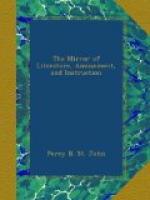“My general appellation amongst my neighbours was ‘the English old woman,’ but in mentioning each other they constantly employed the term ‘lady;’ and they evidently had a pleasure in using it, for I repeatedly observed, that in speaking of a neighbour, instead of saying Mrs. Such-a-one, they described her as ‘the lady over the way what takes in washing,’ or as ‘that there lady, out by the Gulley, what is making dip-candles.’ Mr. Trollope was as constantly called ‘the old man,’ while dray-men, butchers’ boys, and the labourers on the canal were invariably denominated ’them gentlemen;’ nay, we once saw one of the most gentlemanlike men in Cincinnati introduce a fellow in dirty shirt sleeves, and all sorts of detestable et cetera, to one of his friends, with this formula, ’D—— let me introduce this gentleman to you.’”
* * * * *
THE COSMOPOLITE.
SUPERSTITIONS, FABLES, &c. RELATIVE TO ANIMALS.
(Concluded from page 213.)
The oriental fable of the Roc has its probable origin in the condor, which is undoubtedly the largest and strongest bird of the vulture tribe in existence, and extremely ravenous. Minerva’s bird, the Owl, is well known as one of ill omen; besides the superstitious idea that the screech-owl foretells death by its cry, it was formerly believed to suck the blood of children. The Mongol and Calmuc Tartars have held the White Owl sacred since the days of Genghis Khan, when a bird of this species having settled on a bush in which that prince had hidden himself from his enemies, those who pursued him past it, not believing that a bird would perch on a bush wherein a man was concealed. The Raven has ever been considered by the vulgar as a bird of evil omen, the indicator of misfortunes and death; and, indeed, the superstition is but consonant with a bird of such funereal note and hue, and exhibiting such goule-like propensities. The Swedes, however, regard it as sacred, and no one offers to molest it. In the north of England, one Magpie flying alone, is deemed an ill omen; two together, a fortunate one; three forebode a funeral, and four a wedding; or, when on a journey, to meet two magpies portends a wedding; three, a successful journey; four, unexpected good news; and five, that the person will soon be in company with the great. To kill a magpie, indicates or brings down some terrible misfortune. The Sparrow Hawk was sacred with the Egyptians, and the symbol of Osiris. The Yellow Hammer is superstitiously considered an agent diablerie. The Wheat-Ear is, in the Highlands, a detested bird, and fancied one of evil omen, on account of its frequenting old churchyards, where it nestles amongst the stones, and finds plenty of insects for food. The Woodcock is, we believe, the bird imagined to drop, in its proper season, from the moon. It is a vulgar error, that the song of the Nightingale is melancholy, and that it only sings by night; but to hear the Cuckoo before the Nightingale has been long deemed an unsuccessful omen in love: the saliva of the cuckoo has been thought to preserve all it falls upon.




